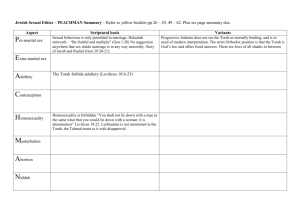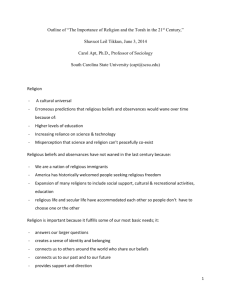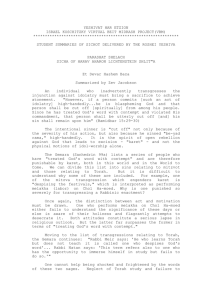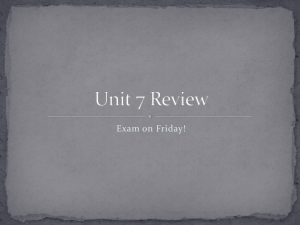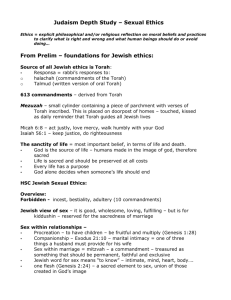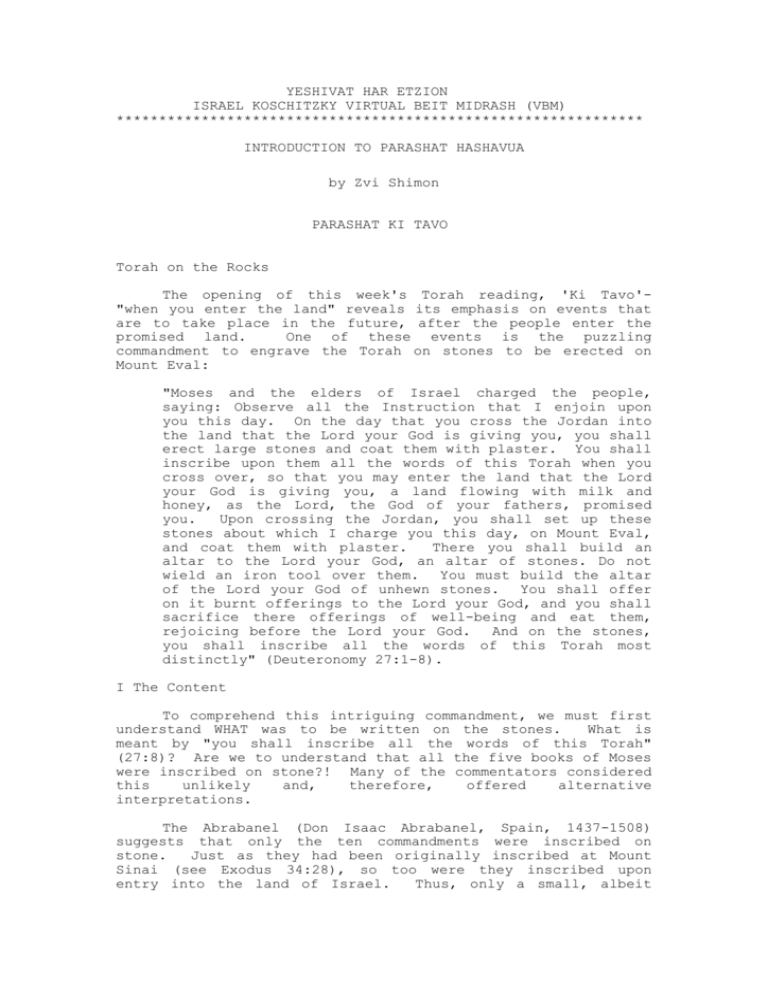
YESHIVAT HAR ETZION
ISRAEL KOSCHITZKY VIRTUAL BEIT MIDRASH (VBM)
**************************************************************
INTRODUCTION TO PARASHAT HASHAVUA
by Zvi Shimon
PARASHAT KI TAVO
Torah on the Rocks
The opening of this week's Torah reading, 'Ki Tavo'"when you enter the land" reveals its emphasis on events that
are to take place in the future, after the people enter the
promised land.
One of these events is the puzzling
commandment to engrave the Torah on stones to be erected on
Mount Eval:
"Moses and the elders of Israel charged the people,
saying: Observe all the Instruction that I enjoin upon
you this day. On the day that you cross the Jordan into
the land that the Lord your God is giving you, you shall
erect large stones and coat them with plaster. You shall
inscribe upon them all the words of this Torah when you
cross over, so that you may enter the land that the Lord
your God is giving you, a land flowing with milk and
honey, as the Lord, the God of your fathers, promised
you.
Upon crossing the Jordan, you shall set up these
stones about which I charge you this day, on Mount Eval,
and coat them with plaster.
There you shall build an
altar to the Lord your God, an altar of stones. Do not
wield an iron tool over them. You must build the altar
of the Lord your God of unhewn stones. You shall offer
on it burnt offerings to the Lord your God, and you shall
sacrifice there offerings of well-being and eat them,
rejoicing before the Lord your God. And on the stones,
you shall inscribe all the words of this Torah most
distinctly" (Deuteronomy 27:1-8).
I The Content
To comprehend this intriguing commandment, we must first
understand WHAT was to be written on the stones.
What is
meant by "you shall inscribe all the words of this Torah"
(27:8)? Are we to understand that all the five books of Moses
were inscribed on stone?! Many of the commentators considered
this
unlikely
and,
therefore,
offered
alternative
interpretations.
The Abrabanel (Don Isaac Abrabanel, Spain, 1437-1508)
suggests that only the ten commandments were inscribed on
stone.
Just as they had been originally inscribed at Mount
Sinai (see Exodus 34:28), so too were they inscribed upon
entry into the land of Israel.
Thus, only a small, albeit
central, part of the Torah was actually engraved in stone.
will analyze the significance of this later.
We
The Rasag (Rabbi Sa'adia Gaon, Persia, 892-942) also
finds it difficult to accept that the whole Torah was
inscribed in stone. He suggests that it was not the text of
the Torah which was written but rather a list of all the 613
commandments in the Torah. Thus, the stone was similar to the
books of commandments ('Sifrei Mitzvot') written in the Middle
Ages listing the commandments.
Although the stones did not
include the text of the Torah, they included the summary of
all the commandments, declaring the obligations of the people
of Israel.
The Ralbag (Rabbi Levi ben Gershom, Provence, 1288-1344)
offers a different possibility:
"I believe that he wrote the blessing and the curse which
they read there, as is written in the Torah and as is
implied in the verse [describing the fulfillment of this
commandment]: "And afterwards he [Joshua] read all the
word of the TORAH, THE BLESSING AND THE CURSE, according
to all that is written in the book of the Torah" (Joshua
8:34).
The word 'Torah' does not relate to the five books of
Moses, nor to any commandments.
It refers to the curse and
blessing which appear in the continuation of our chapter (see
Deuteronomy 27:11 ff.).
This is stated explicitly in the
verse in the book of Joshua in which 'Torah' relates to the
"blessing and the curse."
This curse serves as the
underpinning of the covenant between God and the people of
Israel.
It is to be written on stone and erected on Mount
Eval as a reminder and a warning to the people of the dreadful
repercussions of not fulfilling their covenantal obligations.
In contrast to all the three aforementioned approaches,
the Ramban (Rabbi Moshe ben Nachman, Spain, 1194-1274) cites
an interpretation which holds that the whole Torah, from the
beginning of Genesis till the end of Deuteronomy, was
inscribed in stone:
"We find in the book of Tagin (Authored, according to
tradition, by Joshua who recorded the proper usage of the
tagin.
Tagin are special designs resembling crowns
placed on the upper left-hand corner of seven of the
twenty-two letters of the Hebrew alphabet when writing a
Torah scroll) that the entire Torah was written on them
[the stones] with its crownlets and its embellishments
(different marks found on top of the Hebrew letters in
scripture), and from there all the crownlets in the
entire Torah were copied. It is likely that either these
stones were huge, or it was a miraculous event [for,
otherwise, it would have been impossible to inscribe so
much on a few stone tablets]."
The Ramban stresses that this interpretation is possible
only if the stones were extremely large or alternatively, the
writing of the Torah on them was accomplished through a
miracle.
However, Rabbi Hoffman (Rabbi David Zvi Hoffman,
Germany, 1843-1921) brings archaeological support showing that
the writing of the whole Torah on stone is not such a farfetched idea, and might not have required a miracle. The Code
of Hammurabi, (a code of law from the 18th century BCE
authored by Hammurabi, king of Babylon) composed of 232
articles, an introduction and a conclusion, was inscribed on
one large basalt rock.
Therefore, in our particular case in
which the number of stones is not specified, it is entirely
plausible to interpret that the whole Torah was inscribed on
stone.
According to the source cited by the Ramban, this
"Torah rock" served as a prototype, an authoritative version
of the Torah.
In the biblical period, when texts were
proliferated through manual copying, this was of great
importance. The Torah text requires utmost precision. Every
letter, and even every decoration of the letters is of great
import. In order to prevent the corruption of the text and to
ensure the preservation of the original version of the Torah,
Scripture commands the establishment of an authoritative text
to be visible and accessible to all. This is the function of
the commandment to inscribe the Torah on stone and establish
it in the heart of the country, on Mount Eval in Shekhem.
To
summarize,
we
have
mentioned
four
possible
interpretations of the content matter to be written on the
stones. According to the Abrabanel, it included only the ten
commandments. The Rasag is of the opinion that a list of the
613 commandments was inscribed on the stones, while the Ralbag
suggests that only the blessing and curse, appearing in the
continuation of our chapter, were engraved.
Finally, the
Ramban raises the possibility that the entire Torah was
inscribed in stone.
II The Purpose
Let us now attempt to understand the purpose of this
commandment. Why does the Torah command to inscribe in stone
"all the words of this Torah?"
The rationale offered by the
Torah for this commandment is "so that you may enter the land
that the Lord your God is giving you, a land flowing with milk
and honey, as the Lord, the God of your fathers, promised
you." The Ramban offers two interpretations of this clause:
"[The Torah] states that you should write the whole Torah
on stone immediately upon crossing the Jordan FOR WHICH
SAKE you enter the land, for it is for the sake of the
Torah that you come there ... or its meaning is that you
write the whole Torah as a reminder SO that you may enter
the land, conquer it and inherit all those nations
because you remember the Torah and keep all its
commandments."
According to the first interpretation offered by the
Ramban, the verse should be translated "You shall inscribe
upon them all the words of this Torah when you cross over, FOR
WHICH SAKE you are entering the land."
The writing on the
stone is not a tool for accomplishing a certain end, but is
the end itself. The whole purpose of Israel's entry into the
promised land is so that they spread Torah.
By contrast, according to the second interpretation, the
verse should be translated: "You shall inscribe upon them all
the words of this Torah when you cross over, SO that you may
enter the land." Torah is not the end but the means by which
Israel is to conquer the land. The only way that Israel will
succeed in inheriting the land is if they abide by the laws of
the Torah. Without performance of God's commandments, Israel
has no right and no hope of settling the land. Israel's might
lies in their adherence to the Torah and it is the Torah which
gives them the strength and the merit to overcome their
enemies.
This could help explain the timing of the commandment.
The Torah stresses repeatedly that the commandment should be
performed "upon crossing the Jordan."
This, in spite of the
fact that the stones are to be erected on Mount Eval in
Shekhem, quite a distance from the Jordan River. The writing
of the Torah is intricately connected to the entrance into the
land of Israel. It is the key to the land and must therefore
be prepared immediately upon arrival.
The Abrabanel provides a fascinating historical foil to
this commandment:
"It was an ancient custom amongst all the nations, that
any people or king who conquered a land, immediately upon
entering it, would erect large pillars, one on top of the
other, to mark their having traversed and conquered the
area, and they would inscribe on these pillars that in
the year so and so came the mighty King so and so or the
mighty nation so and so to conquer this land.
Indeed,
throughout Italy and Spain [we may add also throughout
the land of Israel], at any location which came under the
control of the Roman empire at the apex of their
strength, one may find, to this very day, many monuments
that the ancients erected ... and the Israelites were
warned specifically against erecting such monuments upon
crossing [the river], that they should erect them solely
for God's honor, and that they should erect them on Mount
Eval and build there an altar and write upon it not only
the story of their entrance into the land, but also write
all the Torah and the commandments" (Joshua, chapter 8).
The Israelites are not to behave as the Romans or other
conquering peoples. They are not to build monuments to their
own self-glorification.
Rather, they are to build monuments
for the sake of God Who has given them the land.
It is
critical that the nation understand the nature of their
conquest into the land. It is not their own might, but that
of God which allows for their inheritance of the promised
land. We should add that this could be the hidden idea behind
the requirement that the altar be constructed of unhewn stones
on which an iron tool was not wielded (27:5).
It is not
through man's wielding of "iron" that he prevails, but through
his devotion to God and His law.
So far we have concentrated on the timing of the
commandment, "upon crossing the Jordan," and its rationale,
"so that you may enter the land that the Lord your God is
giving you." We have emphasized the role of this commandment
in setting the appropriate frame of mind for the conquest of
the land.
Let us now analyze the other requirements
associated with the inscription of the Torah in stone.
Scripture states that the stones should be coated with
plaster (27:2) and that the words should be inscribed on the
stones "most distinctly"(27:8). We will begin with the first
requirement. What is the function of the plaster? The Bekhor
Shor (Rabbi Yoseph Ben Yitzchak Bekhor Shor, France, 12th
century) explains that the plaster is required so that
"The rains do not blot it [the writing] out.
It [the
plaster] is a durable material which preserves the stones
for a long time, till the people are well versed in the
Torah."
The purpose of the plaster is to preserve the writing on
the stones.
We may infer from this explanation that the
function of the stones on Mount Eval was not only to set the
ideological framework for the entrance and conquest of the
land of Israel; they had a purpose which extended well beyond
the conquest of the land and spanned a far lengthier stretch
of time.
What is this long term function?
The second
requirement, that the words should be inscribed on the stones
"most distinctly," can perhaps help answer this question.
Rashi (Rabbi Shlomo ben Yitzchak, France, 1040-1105) cites the
following homiletical interpretation of our Sages:
"most distinctly"- "in seventy languages"
The number seventy is a generic number which, according
to Tradition, represents the number of the nations of the
earth. According to our Sages, the Torah was inscribed in all
languages. What is the underlying idea behind this fantastic
interpretation? Our Sages understood that the purpose of the
commandment to inscribe the Torah in rock is in order to
spread Torah amongst the nations.
This is the ultimate
purpose of the nation of Israel, to serve as a "light to the
nations,"
the
spiritual
center
of
the
world.
The
establishment of the nation and Kingdom of Israel facilitates
the fulfillment of this function. The commandment to inscribe
the Torah in stone, and according to our Sages, in all the
languages, emphasizes that this is the aim of the nation and
helps accomplish this end.
The Bekhor Shor offers a simpler explanation of the
specification that the words be inscribed "most distinctly."
It is not that the Torah is to be written in different
languages but rather that "the letters should be easily seen
and read." The Torah stipulates that the writing be lucid and
accessible to all. The stones are not to serve, as suggested
by the Ramban in the beginning of this essay, as an
authoritative version of the Torah.
Rather, they are a
national "textbook," a source available for anyone who wishes
to study God's word.
God commands that, immediately upon
entering the land, the people inscribe the Torah so that the
whole nation may study His law.
Rabbi Hoffman adds a slightly different
explaining the purpose of the Torah stones:
tint
in
"Through the inscription of the Torah on stones and their
placement in a location visible to all, the nation
publicly testifies that the Torah is the eternal law of
the land; it is the law of the kingdom and of every
single individual."
The purpose of the stones is not only to abet the
education of the people.
They are also a declaration of the
supremacy of the Torah as the law of the land.
The Abrabanel draws an interesting parallel between the
inscription of the Torah on stone and another commandment in
the Torah, that of the 'mezuza.'
The Torah commands, "write
them [the words of the Torah] on the 'mezuza' (doorposts) of
your houses and on your gates" (Deuteronomy 6:9).
Certain
portions of the Torah are written on the entrance of every
Jewish home thereby declaring the home as a house of Torah.
In addition, the words of Torah must be written on the gates
of the city.
The Abrabanel suggests that the inscription of
the Torah on stones upon entry into the land is an extension
of these commandments to the national level.
Torah is to be
written at the entrance to every home and city, and in the
center of the country, on Mount Eval.
God's law encompasses
every family, and city, and the nation as a whole.
The Rashbam (Rabbi Shmuel ben Meir, France, 1080-1160)
suggests an additional dimension to the commandment to
inscribe the words of the Torah in stone:
"As they [the people] took an oath at Mount Gerizim and
Mount Eval, the Torah was before them and they swore to
fulfill [its commands]."
The Rashbam infers from the context of our section that
the inscription of the Torah in stone is part of a covenantal
oath to be taken upon entry to the land, at Mount Eval and
Mount Gerizim.
The section immediately following ours,
relates the curses of those who disobey God's word. Blessings
and curses are a central component of the forging of covenants
in the Bible. They are a form of legal contract which oblige
and bind both sides.
God promises reward for the keeping of
his commandments and punishment for disobedience.
This theme is expanded by the Abrabanel:
"After Moses had clarified the commandments which
required clarification ... he saw fit to forge a covenant
for their realization.
For just as in the book of
Leviticus (26:3 ff), following the commandments which
they received at Mount Sinai, God forged a covenant with
the people of Israel and enumerated the blessings for
those who adhere to the commandments and the curses
befalling those who disobey them; so too, Moses, after
elucidating
the
commandments
[in
the
book
of
Deuteronomy], forged a covenant and enumerated the
blessings and curses as he did at Mount Sinai.
At the
covenant at Mount Sinai, following the elucidation of the
commandments the Torah states: "Moses wrote down all of
God's words...and built an altar at the foot of the
mountain, along with twelve pillars for the twelve tribes
of Israel ... and they offered burnt offerings and
sacrificed bulls as offerings of well-being to the Lord"
(Exodus, 24:4-5).
Therefore, he commanded them [the
people] that, upon entering the land, they should do
similarly to what they did following the event [at Mount
Sinai], namely to erect the stones."
The Abrabanel points out several similarities between the
covenant at Mount Sinai and the covenant at Mount Eval.
First, the focus point of both covenants is the inscription of
Torah in stone.
In fact, according to the Abrabanel, the
inscriptions were identical!
We'll recall that he is of the
opinion that, similarly to the covenant at Mount Sinai, only
the ten commandments were inscribed on the stones at Mount
Eval. Second, both covenants are buttressed by blessings and
curses ensuing from the observance or the disobedience of the
commandments of God.
Third, both covenants are followed by
the construction of an altar, the offering of sacrifices, and
a joyous celebration. In addition, both covenants take place
on mountains.
The similarities are far too many to be
considered coincidental.
How are we to understand this
striking similarity? Why was a second covenant at Mount Eval
necessary? (Take a few moments to reflect upon the question.)
I believe that the need for the second covenant stems
from the nation's entrance into the land of Israel.
The two
covenants are actually one and the same.
However, it is
necessary to repeat the covenant in the land of Israel.
Its
repetition signifies the carrying over of the covenant, of the
commandments of God, into the land.
The Torah received at
Mount Sinai must be implanted in the soil of Israel.
The
writing of the Torah on rocks and their erection on Mount Eval
expresses the idea of the transfer of the original covenant
from the desert to the fertile promised land.
The original
covenant took place outside of the land of Israel. The reason
for this is that the Torah is not dependent or confined to
Israel.
It is to be observed wherever the nation may find
itself. It precedes the entry into the land and is, in fact,
a necessary prerequisite.
However, ultimately and ideally,
the covenant relates to a state in which the people dwell on
their own soil. This is the idea behind the covenant at Mount
Eval.
To summarize, we have seen several explanations for the
commandment to inscribe the Torah in stone.
The first
explanation, cited by the Ramban, is that the stones served as
a prototype, an authoritative version of the Torah. A second
explanation is that the stones were meant to prepare the
ideological framework for the entrance and conquest of the
land of Israel. According to the interpretation of our Sages
as cited by Rashi, the commandment included the translation of
the Torah into seventy languages and its purpose is to spread
Torah amongst the nations.
Other suggestions include the
education of the people (Bekhor Shor), the establishment of
the Torah as the law of the land (Rabbi Hoffman), and finally,
the reenactment of the covenant at Mount Sinai (Abrabanel).
III The Repetition
We now have a better understanding of the commandment of
inscribing the Torah in stone.
However there remains a
serious textual difficulty in our section. Anyone reading the
verses cited in the beginning of this article immediately
notices repetitions.
(It is advisable to return to the
beginning of the article and re-read the section.) The Torah
repeats the timing of the commandment, upon crossing the
Jordan.
Likewise, the requirement to coat the stones with
plaster and to inscribe upon them the words of the Torah are
stated twice!
What is the reason for this apparent
redundancy?
Rabbeinu Bechayei (Rabbi Bechayei ben Asher, Spain, end
of 13th beginning of 14th century) suggests that our section
is a 'klal u-prat,' a general scheme followed by a more
elaborate description. The Torah first gives the overview of
the commandment, the requirement to write the Torah on stones
etc., and then elaborates on all the details including the
specific location, Mount Eval, and the requirement of
constructing an altar.
Do you find this explanation
convincing?
I believe a close analysis of our verses forces us to
reject this interpretation.
A 'klal', a general overview,
should only include the central attributes of the case at
hand.
In our specific example this would include the
obligation to write the Torah and to build an altar. However,
the details repeated in the verses include some which are much
more particular in nature. It is hard to understand why such
minutiae as coating the stones in plaster should be included
in an overview! In addition, there is very little information
added in the elaboration of the overview. The section simply
doesn't give the impression of being organized in the manner
suggested by Rabbeinu Bechayei.
I would like to suggest that the repetitions in our
verses are indicative of two separate motives for the
inscription of Torah in stone. We may divide our section into
two similar yet separate accounts of the commandment:
1) "On the day that you cross the Jordan into the land that
the Lord your God is giving you, you shall erect large stones
and coat them with plaster. You shall inscribe upon them all
the words of this Torah when you cross over, so that you may
enter the land that the Lord your God is giving you, a land
flowing with milk and honey, as the Lord, the God of your
fathers, promised you."(27:1-3)
2) "Upon crossing the Jordan, you shall set up these stones
about which I charge you this day, on Mount Eval, and coat
them with plaster. There you shall build an altar to the Lord
your God, an altar of stones ... And on the stones, you shall
inscribe all the words of this Torah most distinctly"
(Deuteronomy 27:4-8).
Both accounts begin in a similar manner, with the
specification of the timing of the commandment.
The major
differences are that the rationale "that you may enter the
land that the Lord your God is giving you" appears only in the
first account, while only in the second passage is there a
specification of the location where the stones are to be
erected, on Mount Eval, and the commandment regarding the
construction of the altar.
I would like to suggest that the first account of the
commandment relates solely to the immediate function of the
inscription in preparing the ideological framework for the
entrance and conquest of the land of Israel. By contrast, the
second account concentrates on the long-term function of the
commandment.
Hence the exclusive mention of the rationale
"that you may enter the land that the Lord your God is giving
you" in the first account.
The motive of the commandment in
the first account is to insure the nation's entry into the
promised land. This explains the exclusion of the location in
which the stones are to be erected. Mount Eval is deep in the
land of Israel, quite a distance from the Jordan River.
The
future covenant at Mount Eval is not the topic of the first
account.
The first account concentrates exclusively on the
act of crossing the Jordan River. This also explains a minor
linguistic difference between the specification of the time of
the commandment in the two accounts. As opposed to the second
account in which the timing of the commandment is "upon
crossing the Jordan," the first account states "on the DAY
that you cross the Jordan."
The first passage specifies the
very day of crossing while the second is satisfied with a more
general description.
The second account concentrates on the
long term function of the Torah stones.
It is interested in
the erection of the stones on Mount Eval and the covenant to
be forged there. Hence the mention of the altar pertaining to
the covenant at Mount Eval, only in the second account. There
is indeed a dual function to the inscription of the Torah in
stone. It is the means by which Israel may enter the promised
land. It is only by virtue of the Torah that Israel has the
right to settle the land.
In addition, it is also the
ultimate purpose and destiny of the nation of God.
Israel's
function is to serve as the spiritual center of the world.
Torah is the means by which Israel becomes a nation and it is
also the ultimate purpose of Israel's existence.
Yeshivat Har Etzion
and
Congregation Kehilath Jeshurun
Cordially invite the entire community
to a
TESHUVA DRASHA
Dedicated in Memory of
Rose and Alexander Shapiro
and
Frances Schreiber-Feder
Delivered by our Rosh Yeshiva
HARAV AHARON LICHTENSTEIN
On the topic of
"The Integrity of Teshuva"
Thursday evening, September 18 - 8:00 p.m.
at
Congregation Kehilath Jeshurun
125 East 85th Street, New York City
For more information, contact
The Etzion Foundation at (212) 732-4874 (GUSH)
or Congregation Kehilath Jeshurun at (212) 427-1000
**************************************************************
For direct questions or comments to Zvi Shimon, please send
email to intparsh@etzion.org.il .
**************************************************************
BE SURE TO VISIT THE "VIRTUAL CITY OF JERUSALEM"
WWW.VIRTUAL.CO.IL
**************************************************************
VISIT YHE'S WEB SITE:
HTTP://WWW.VIRTUAL.CO.IL/EDUCATION/YHE
**************************************************************
To
subscribe
send
e-mail
to:
LISTPROC@VIRTUAL.CO.IL:
subject:(leave blank or type word 'subscription'), on first
line of text type: sub YHE-INTPARSHA <your full name> .
Copyright (c)1997 Yeshivat Har Etzion.
All rights reserved.
**************************************************************
SHIURIM MAY BE DEDICATED TO VARIOUS OCCASIONS - YAHRZEITS, SEMACHOT,
BIRTHDAYS, ETC. PLEASE E-MAIL YHE@VIRTUAL.CO.IL FOR AN APPLICATION.
YESHIVAT HAR ETZION
ISRAEL KOSCHITZKY VIRTUAL BEIT MIDRASH
ALON SHEVUT, GUSH ETZION 90433
E-MAIL: YHE@VIRTUAL.CO.IL or OFFICE@ETZION.ORG.IL

